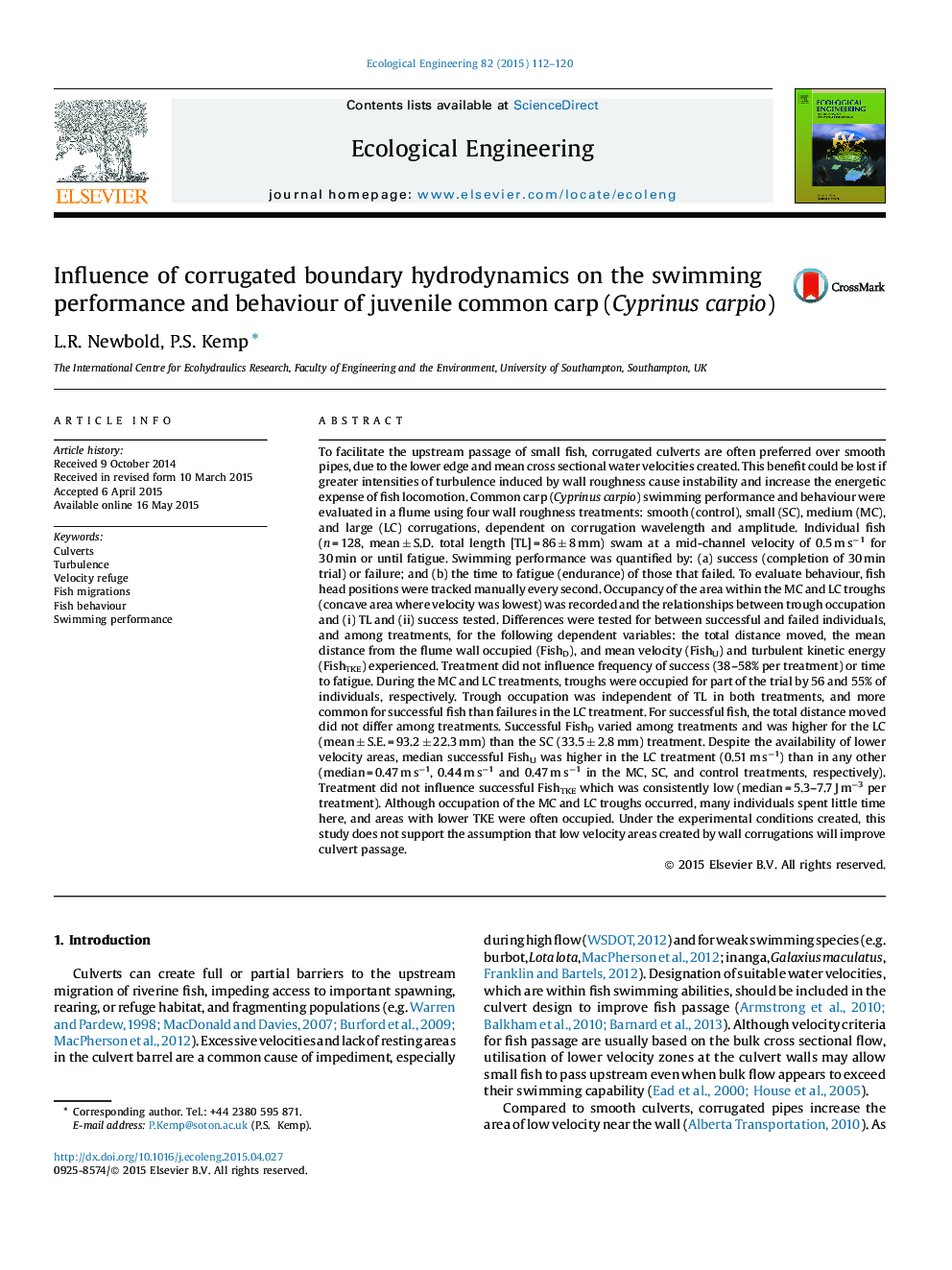| کد مقاله | کد نشریه | سال انتشار | مقاله انگلیسی | نسخه تمام متن |
|---|---|---|---|---|
| 4388954 | 1618017 | 2015 | 9 صفحه PDF | دانلود رایگان |

• Carp swimming performance and behavioural response to corrugations were assessed.
• Corrugations did not improve swimming performance compared to smooth walls.
• Fish could occupy low velocity areas within large and medium corrugation troughs.
• Fish often swam in higher velocity, lower TKE flow, away from larger corrugations.
• Turbulence near the corrugated walls may have reduced fish stability.
To facilitate the upstream passage of small fish, corrugated culverts are often preferred over smooth pipes, due to the lower edge and mean cross sectional water velocities created. This benefit could be lost if greater intensities of turbulence induced by wall roughness cause instability and increase the energetic expense of fish locomotion. Common carp (Cyprinus carpio) swimming performance and behaviour were evaluated in a flume using four wall roughness treatments: smooth (control), small (SC), medium (MC), and large (LC) corrugations, dependent on corrugation wavelength and amplitude. Individual fish (n = 128, mean ± S.D. total length [TL] = 86 ± 8 mm) swam at a mid-channel velocity of 0.5 m s−1 for 30 min or until fatigue. Swimming performance was quantified by: (a) success (completion of 30 min trial) or failure; and (b) the time to fatigue (endurance) of those that failed. To evaluate behaviour, fish head positions were tracked manually every second. Occupancy of the area within the MC and LC troughs (concave area where velocity was lowest) was recorded and the relationships between trough occupation and (i) TL and (ii) success tested. Differences were tested for between successful and failed individuals, and among treatments, for the following dependent variables: the total distance moved, the mean distance from the flume wall occupied (FishD), and mean velocity (FishU) and turbulent kinetic energy (FishTKE) experienced. Treatment did not influence frequency of success (38–58% per treatment) or time to fatigue. During the MC and LC treatments, troughs were occupied for part of the trial by 56 and 55% of individuals, respectively. Trough occupation was independent of TL in both treatments, and more common for successful fish than failures in the LC treatment. For successful fish, the total distance moved did not differ among treatments. Successful FishD varied among treatments and was higher for the LC (mean ± S.E. = 93.2 ± 22.3 mm) than the SC (33.5 ± 2.8 mm) treatment. Despite the availability of lower velocity areas, median successful FishU was higher in the LC treatment (0.51 m s−1) than in any other (median = 0.47 m s−1, 0.44 m s−1 and 0.47 m s−1 in the MC, SC, and control treatments, respectively). Treatment did not influence successful FishTKE which was consistently low (median = 5.3–7.7 J m−3 per treatment). Although occupation of the MC and LC troughs occurred, many individuals spent little time here, and areas with lower TKE were often occupied. Under the experimental conditions created, this study does not support the assumption that low velocity areas created by wall corrugations will improve culvert passage.
Journal: Ecological Engineering - Volume 82, September 2015, Pages 112–120